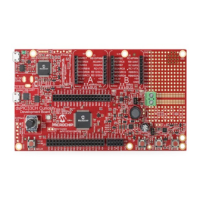dsPIC33CH CURIOSITY DEVELOPMENT
BOARD USER’S GUIDE
2018 Microchip Technology Inc.
Advance Information
DS50002762A-page 13
Chapter 2. Hardware
2.1 POWERING THE BOARD
2.1.1 USB Power
The board is intended to be primarily powered from the PKOB USB micro-B connector
J20. Power is not sourced through USB connector J16, as it is part of the isolated
USB-UART interface. The official “USB 2.0 Specification” restricts USB applications to
consuming no more than 500 mA of USB V
BUS
power from the host. Polyfuse TH1 is
rated for 500 mA to enforce the USB current restrictions and to help protect the board,
or host, from damage in the event of unintended short circuits or SMPS output
overloads.
When operating the board from USB power, approximately 300 mA of V
BUS
current is
available to the SMPS circuit, as about 200 mA of the total should be reserved for use
by the other non-SMPS circuitry on the board (ex: primarily U1, U4, U11, R17,
LED5, etc.).
2.1.2 External Power
An external DC wall cube may optionally be connected if a DC barrel jack is installed
in the unpopulated footprint J17. If an external wall cube is used, it should be well
regulated and rated for 5.0V, ≤1.5A, with center pin positive. Compared to operating
from USB power, powering the board with an external wall cube enables more power
to be sourced by the SMPS circuit on the board. It is not necessary to use an external
power supply for standard operation at lower current levels (e.g., SMPS circuit output
load power of about <1.2W).
When the board is powered through J17, the polyfuse TH1 is bypassed, and therefore,
it is recommended to use a wall cube with internal short circuit and overload protection
(≤1.5A) to minimize the risk of circuit damage in the event of unintended short circuits.
Additionally, if an external wall cube is used, it is recommended to cut a trace (NT2 on
the top of the PCB) and populate D1 with a ≥1A rated Schottky diode (SOD-123). This
will prevent any USB V
BUS
“backdrive” current from flowing out of the wall cube and
into the attached host via J20. USB V
BUS
backdrive currents may not necessarily be
destructive (when limited in current level), but are a USB compliance violation. They
can interfere with the host operation, especially when the host is unpowered. This
scenario can be avoided, however, via D1.

